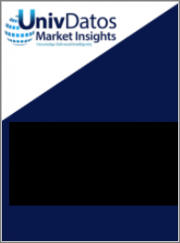
신경보호 시장은 신경질환의 유병률 증가에 의해 약 6%의 안정된 성장이 전망됩니다. 알츠하이머병, 파킨슨병, 다발성 경화증 등 신경질환의 발생률은 고령화, 유전적 소인, 라이프스타일 요인 등의 요인에 의해 증가하고 있습니다. 예를 들면 WHO 발표에 따르면 2021년에는 5,500만 명 이상이 치매로 진단되었으며, 매년 약 1,000만 명이 새롭게 발병하고 있습니다. 또한 2019년에는 세계 전체에서 5,000만 명 간질로 진단되었습니다.
제품 유형에 기반하여 시장은 프리 라디칼 포착제(항산화제), 아포토시스 저해제, 항염증제, 글루타민산 길항제(항자극 독성제), 기타로 구분됩니다. 프리 라디칼 포착제(항산화제) 카테고리는 고령화, 알츠하이머병이나 파킨슨병 등 신경변성질환의 이환율 상승에 기인하고, 예측 기간 중 높은 CAGR을 보이며, 이 부문의 성장을 한층 더 지원하는 신경보호 치료에 대한 수요를 촉진하고 있습니다.
용도별로는 신경변성질환, 알츠하이머병, 파킨슨병, 다발성 경화증, 기타로 분류됩니다. 이 중 신경변성질환이 2021년 시장에서 큰 점유율을 차지하고 있습니다. 이것은 주로 신경 변성 장애의 유병률 증가, 뇌 건강 유지의 중요성에 대한 의식의 향상, 효과적인 치료법의 필요성이 신경보호 시장의 성장을 촉진하고 있기 때문입니다. 예를 들면 국제암연구기관에 따르면 세계의 대부분의 조사에서 10만 명당 10-15명의 연간 발증률이 지적되고 있습니다. 65세 이상에서 유병률은 2%에 달할 가능성이 있습니다.
조사 대상은 최종사용자별로 병원·전문 클리닉, 연구기관·학술 센터, 요양시설, 기타로 분류됩니다. 예측 기간 중 병원·전문 클리닉 카테고리에서 신경보호의 채택이 증가할 것으로 보입니다. 이것은 주로 신경질환의 보다 정확한 진단을 받기 위해 입원을 희망하는 환자가 많은 것, 신경질환의 유병률 증가, 맞춤형 의료에 대한 수요의 증가 등이 신경과학 시장에서 헬스케어 프로바이더 분야의 성장을 촉진하고 있기 때문입니다.
신경보호 업계의 시장 도입에 관한 심층 이해를 위해 시장은 북미(미국, 캐나다, 기타 북미 지역), 유럽(독일, 영국, 프랑스, 스페인, 이탈리아, 기타 유럽 지역), 아시아태평양(중국, 일본, 인도, 기타 아시아태평양), 기타 지역에서 세계의 존재에 기반하여 분석되고 있습니다. 북미는 노인 인구가 대부분 미국 사회의 대부분을 차지하고 있으므로 예측 기간 중 상당한 CAGR로 성장할 것으로 예상되고 있습니다. 지역 생활 행정에 따르면 2019년에는 2009년 이후 미국 고령자수는 1,440만 명(또는 36%) 증가하고 있습니다. 연령의 상승에 수반하여 신경장애의 리스크도 증가하며, 이것은 증가하는 증례에 대처하기 위한 신경보호 시장의 성장에 중요한 요인이 됩니다. 또한 이 지역 및 미국 등의 주요 경제권에서 첨단 기술의 존재도 북미에서 신경보호 산업의 시장 점유율이 큰 요인입니다.
Neuroprotection refers to the process of protecting the nervous system from damage or degeneration. The nervous system is a complex network of cells and tissues that controls the body's functions, including movement, sensation, and cognition. Neuroprotection can be achieved through various means, including the use of drugs, therapies, and lifestyle modifications. For example, drugs that target specific proteins or enzymes involved in the process of neurodegeneration can be used to protect the nervous system. Therapies such as physical therapy, occupational therapy, and speech therapy can also be used to protect the nervous system by promoting nerve function and preventing further damage.
The neuroprotection market is expected to grow at a steady rate of around 6% owing to the Increasing prevalence of neurological disorders. The incidence of neurological disorders such as Alzheimer's disease, Parkinson's disease, and multiple sclerosis is increasing due to factors such as an aging population, genetic predisposition, and lifestyle factors. For instance, as per WHO, more than 55 million people were diagnosed with dementia in 2021, and there are nearly 10 million new cases every year. Also, in 2019, globally, 50 million people were diagnosed with epilepsy.
Based on product type, the market is segmented into free radical trapping agents (antioxidants); apoptosis inhibitors; anti-inflammatory agents; glutamate antagonists (anti-excitotoxic agents); and others. The free radical trapping agents (antioxidants) category to witness higher CAGR during the forecast period owing to the aging population and the rising incidence of neurodegenerative diseases such as Alzheimer's and Parkinson's are driving the demand for neuroprotection treatments which will further boost the growth of this segment.
On the basis of application, the market is categorized into neurodegenerative disorders, alzheimer's disease, parkinson's disease, multiple sclerosis, and other. Among these, the neurodegenerative disorders held a significant share in the market in 2021. This is mainly due to the increasing prevalence of neurodegenerative disorders, the growing awareness of the importance of maintaining brain health, and the need for effective treatments are driving the growth of the neuroprotection market. For instance, as per International Agency for Research on Cancer, annual incidence rates of 10-15 per 100 000 have been noted in most surveys worldwide. Prevalence may reach 2% in persons aged 65 years and older
Based on end-user, the neuroprotection market has been classified into hospitals & specialty clinics, research institutes & academic centers, long-term care facilities, and others. The hospitals & specialty clinics category is to witness higher adoption of neuroprotection during the forecast period. This is mainly due to the high preference of patients for hospitalization to have a more accurate diagnosis of their neurological diseases, increasing prevalence of neurological disorders, coupled with the rising demand for personalized medicine, is driving the growth of the healthcare provider segment in the neuroscience market.
For a better understanding of the market adoption of the neuroprotection industry, the market is analyzed based on its worldwide presence in the countries such as North America (U.S., Canada, Rest of North America), Europe (Germany, U.K., France, Spain, Italy, Rest of Europe), Asia-Pacific (China, Japan, India, Rest of Asia-Pacific), Rest of World. North America is anticipated to grow at a substantial CAGR during the forecast period. owing to the North America is home to a large geriatric population and consists of a significant portion of American society. As per the administration for community living, the number of older Americans has increased by 14.4 million (or 36%) since 2009 in 2019. With the rising age, the risk of neurological disorders also increases which becomes an important factor for the growth of the neuroprotection market to deal with the increasing cases. Furthermore, the presence of advanced technology in the region and the major economies such as the U.S. is also a responsible factor for the large market share of neuroprotection industry in North America.
Some of the major players operating in the market include: AbbVie Inc.; DAIICHI SANKYO COMPANY; Astrocyte Pharmaceuticals; AstraZeneca; Biogen; Novartis AG; Lilly; F. Hoffmann-La Roche Ltd; Teva Pharmaceutical Industries Ltd.; and Merck KGaA.